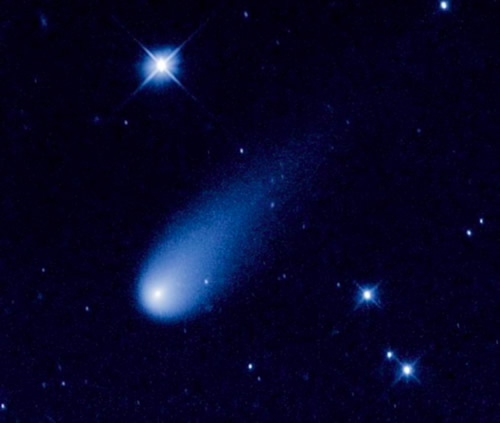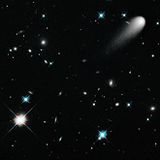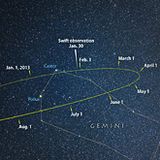
After re-emerging from behind the Sun, Comet ISON is appearing a little earlier, and a little less bright than predicted. Tammy Plotner gathers up the arguments in the heated debate over Comet ISON's possible outcome.
With the glory days of Comet PANSTARRS now finished, amateur astronomers are turning anxious eyes towards C/20012 S1 ISON. According to the latest media buzz, amateur imager Bruce Gary in Arizona has become the first person to pick up Comet ISON upon its return to visible skies. While this is exciting news, it comes with a price: It would seem that things aren't quite as bright as anticipated.
At only six degrees above the horizon and racing just slightly ahead of dawn, Gary's photographic observations of Comet ISON place the distant traveler at roughly magnitude of 14.3 - about two magnitudes fainter than modeling predicted it should be. It would seem that the comet hasn't changed much since it was last observed at the end of May - again about two magnitudes less than figured. Is this lack of brightness an indicator that ISON might not perform like a sparkling firework? According to some researchers, track records of past comets that held a steady brightness for a certain amount of days meant the comet was going to fail. Reality check, it's just too early to favor any one opinion. Let's take a look at some facts.
When astronomers last had a good look at Comet ISON, it was doing exactly what it was expected to - spewing out carbon-dioxide and holding a steady magnitude. At the time, it was losing around 2.2 million pounds of mass on a daily basis and some of that material could be masking other volatiles which could make it brighter. However, that's not the only reason. At this point we really need to remember that Comet ISON is still too far from the Sun to be producing water and dust activity.

Image © NASA, ESA, and the Hubble Heritage Team (STScI/AURA)
"ISON's brightness remained more or less stable for much of the early part of the year, but this doesn't surprise us enormously," says Karl Battams, an astrophysicist and computational scientist based at the Naval Research Laboratory in Washington DC. "It is still outside of what we call the 'frost line' - - the point in space at which water-ice (the dominant component of comets) begins to sublimate. Once it passes this mark in late August, we expect to see a more significant increase in brightness."
Is Comet ISON still too cool to create much activity? As we know, comets display huge comas and long tails when the ices near their surface are heated to the point where they begin to sublimate into gas. As the gas escapes, it captures dust grains along with it, dragging it across space and giving the comet its characteristic appearance. The huge amount of materials escaping ISON leads to speculation - and the speculation is that the comet may have already run out of fuel and will fade away.
"Comets are notoriously unpredictable so there is certainly a chance that this is true. However, I see this as unlikely. As discussed above, ISON hadn't yet reached the frost line during all observations to date, so unless it had little to no water to begin with (something that is unheard of in a comet), it should not have already lost its water," says Matthew Knight (Lowell Observatory, Flagstaff, AZ), an astronomer specializing in comet nucleus and coma studies. "Comparisons to comets that had flat lightcurves before disappearing aren't really comparing apples to apples if one comet is in the region where water should have been vigorously active for a while, whereas ISON hasn't even begun water ice sublimation yet."
Comet ISON's position in our solar system is just one of many reasons it's not behaving like a circus act. You cannot demand an astronomical subject to perform in any expected way - especially if it's unique. According to NASA's Comet ISON Observing Campaign (CIOC), C/2012 S1 can be classified as a "sungrazer", but it's not a member of the Kreutz group of comets, which scientists believe may have been spawned by a series of splits from a single progenitor comet sometime during the last few thousand years. Kreutz comets have periods of 500-1000 years and are therefore not dynamically new since they (or their parents) have been through the inner solar system before and this is ISON's first journey around the Sun.
"To the best of my knowledge there has never been a dynamically new Oort Cloud comet that had a smaller perihelion distance than ISON. Note, however, that reliable orbits go back only about 200 years, and a comet must be well observed to conclusively determine that it is newly arrived from the Oort Cloud as opposed to just having a long period," says Knight. "There have been no known dynamically new sungrazing comets in at least 200 years. Comet ISON really is unique!"
And if you're a die-hard comet observer, the "from one extreme to the other" hype really doesn't matter. While it would be great fun to have another comet as splashy as Hale-Bopp to study, there's absolutely nothing wrong with following ISON's activity, no matter what the outcome.
"ISON still hasn't brightened as much as initial projections suggested it might. But, again, this shouldn't have been shocking news to those familiar with observations of comets making their first passage through the inner solar system," furthers Knight. "For reasons that are not entirely understood, these "dynamically new" comets tend to brighten at a much slower rate than comets that have been around the Sun before. ISON's initial rate of brightening was much higher than is typical for dynamically new comets and, sure enough, it slowed down dramatically soon thereafter."
Need even more fuel to add to the speculation fire? Then consider Comet ISON still has to survive its pass around the Sun, and exposure to the million degree solar corona. Can it last through the Roche limit? Will it be able to withstand tidal shearing and extreme pressure? No one can answer these questions with certainty. We simply don't know if ISON's nucleus is compact enough or large enough to survive a trial by fire. It might simply blow itself apart as it approaches the Sun, flaring up brightly and then scattering away like space seed on the solar wind.
For those of us who routinely observe comets, we're used to seeing nothing more than a very small fuzz ball and every so often, one that displays a tail. It's rare to see a comet that doesn't require optical aid and even rarer to have one which might become excitingly bright. While it's fun to think Comet ISON might outshine the full Moon, it's equally fun to think that Mars might be as large, too. It's all excitement in reporting, and reporting also means taking an accurate and scientific standpoint as well. For now, heartfelt congratulations go out to Bruce Gary for his excellent work in recovering Comet ISON and his well-done homework. We need to smile at the hype and simply wait and see what happens.
"Certainly if you browse around online you will find references to estimates of magnitude -10 or even -15, and the term 'Comet of the Century' has been tossed around with abandon," concludes Knight. "Those are not the words of the CIOC Team, and while they may perhaps turn out to be true, we think it highly unlikely. More likely, ISON will be one of the brightest comets in the past several years and, thanks to the global astronomy community, we hope one of the most broadly observed comets in history!"
Rock on...
About Tammy Plotner - Tammy is a professional astronomy author, President Emeritus of Warren Rupp Observatory and retired Astronomical League Executive Secretary. She's received a vast number of astronomy achievement and observing awards, including the Great Lakes Astronomy Achievement Award, RG Wright Service Award and the first woman astronomer to achieve Comet Hunter's Gold Status.



















